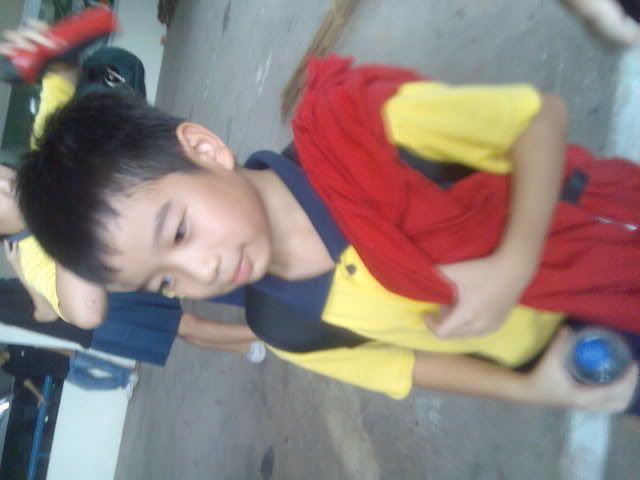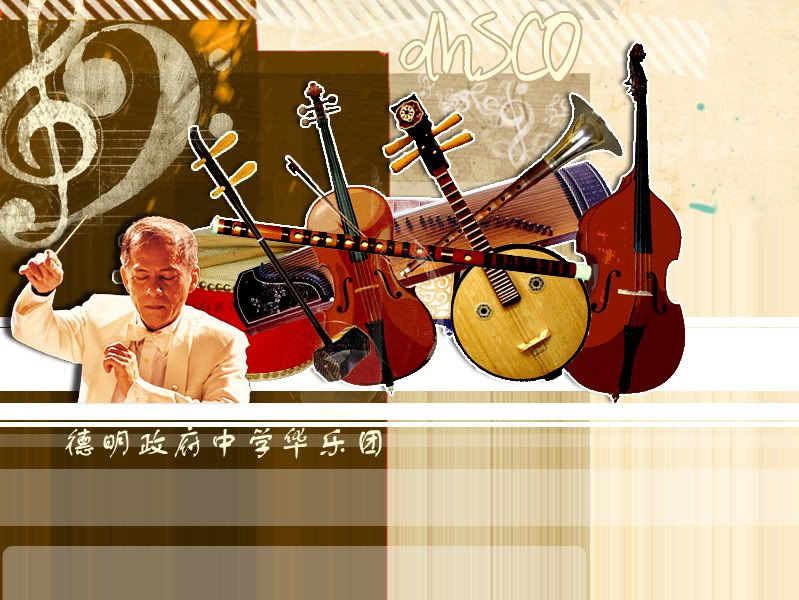This blog is dead. ):
Due to popular demand, I shall talk about EZCO!
THE KIDS ARE VERY CUTE!Yar! There's this very cute liuqin boy from ngeeann pri (PS: I'm not a paedophile!) :

Cute right! Pls agree hoho. (:
And here's a pic of the dazu LOL:

It's rather blurred lols. Can see 郑老师 lifting his hand, conducting!
Haha. Now, lets advertise for this concert (again)..

弦筝和韵 笙管齐鸣 / Sounds of War! It's a very nice concert, with many nice songs to be performed. Please go! (:
DATE02 Dec 2007 Sun, 5PM
VENUE
Victoria Concert Hall
TICKET PRICE (Exclude Booking Fee)
Standard - S$15, S$12.
Please add to above price $1 Booking Fee for tickets $20 and below. Charges include GST where applicable.
SYNOPSISThe NAFA City Chinese Orchestra presents its popular classics series with invited guests from the Shanghai Conservatory of Music.The orchestra will perform well-loved orchestral pieces on the theme of war. For instance, Fantasia “Terra-cotta Warriors” and “Qin Wang’s Victorious Campaign”. In addition, the guests will perform a repertoire of solo instrumental pieces on the erhu and sheng, while budding talented Chinese orchestra enthusiasts will perform technically challenging pieces such as the “Capriccio of Liangshan”.
DURATIONApprox 2 Hrs
Interval - Approx 15 Mins
Details above are from
http://www.sistic.com.sg/cms/events/index.html?content=1325. Click to find out more!
(:
Happy holidays!
-yilin!
dhsco played at Thursday, 15 November 2007; 22:58
HOHOHO!
MERRY BE-EARLIED X'MAS! :D
santa claus is coming~
to town! (victoria concert hall!)
dhsco played at Sunday, 11 November 2007; 21:49
Hello Dhscoians,
Please do give them your support! ;)
it'd be fun it'd be fun, you guys can go together in groups and take it as an opportunity to meet up during the long holidays.
Sounds of War
The NAFA City Chinese Orchestra presents its popular classics series presented both by the Orchestra and invited examiners from the Shanghai Conservatory of Music. The Orchestra would present the best-loved orchestral pieces on the theme of war such as Fantasia “Terra-cotta Warriors”. The examiners would also perform a repertoire of solo instrumental pieces, such as those of the erhu and sheng, at the concert. In addition, outstanding music students taking the examinations jointly organized by the Shanghai Conservatory of Music and Shangyin Music School would present several pieces.
Date : 2 Dec 2007 (Sunday)
Time : 5pm
Venue : Victoria Concert Hall (VCH)
Ticket Prices : $12, $15 (exc SISTIC charge)
Tickets : SISTIC (63485555)
------------------------------------------------------------------------------------------------------------------------------------
Capriccio of Liangshan (Suona Concerto)
Composed by Zhang Xiaofeng
Suona soloist: Ho Jun Jie, Kelvin
During the reign of Emperor Huizong of the Song Dynasty, power was abused in the hands of court eunuchs, leading to widespread poverty and suffering among the civilians. Eventually, a group of commoners decided to rebel against the officials and gathered at Liangshan Mountain to carry out guerilla warfare.
Waters at the foot of Liangshan paint a picturesque scenery. The heroes, mostly peasants, come together to train their martial skills; they also indulge in drinking with much fervor. With the sounding of the war drums and horns, the battle begins; when the heroes emerge triumphant, they celebrate with joy.
Generations have passed, and the circumstances at Liangshan have changed tremendously. However, the valiant spirit of the heroes continues to live on. As visitors ascend the mountain year after year, they would never fail to pay their respects to these eternal heroes.
The piece is divided into three sections:
1. The Long March: Adagio, brimming with emotion
2. Preparation for Battle: Dainty Allegretto, Allegro
3. The Valiant Spirit Lives On: Melancholy Lento, Largo
------------------------------------------------------------------------------------------------------------------------------------
King Qin’s Victorious Campaign (Orchestral)
Traditional Composed by Gu Guanren
The “Victorious Campaign” was a military song towards end of the Sui Dynasty (581 A.D. to 618 A.D.). In 620 A.D., the military and the people rewrote the lyrics of the song to praise the second emperor of the Tang Dynasty, Li Shimin, for his success in defeating the rebellious generals. The song was sung during the celebration of ceremonies and became the initial version of the “Victorious Campaign”. In 633 A.D., the piece was rearranged into a piece of dance music under the direction of Li Shimin. The dance music is powerful and evocative and became well-known in India and Japan.
------------------------------------------------------------------------------------------------------------------------------------
Fantasia “Terra-cotta Warriors” (Orchestral)
Composed by Peng Xiuwen
The excavation of the clay figures of warriors and horses from the imperial tomb of the Qin Dynasty has caused worldwide excitement. The unification of China accomplished by the First Emperor was a widely-recognised historical and military achievement. However, the regime lasted only for 15 years because the people could not stand the Emperor’s despotic and oppressive rule. Instead of focusing on the excavated clay figures, the piece focuses on the soldiers’ lengthy service during the Qin Dynasty. It depicts the misery of the soldiers who hardly got the chance to be home with their families. It also demonstrates the yearning of their families, which waited anxiously for their return. Hence, the work is structured like a fantasy, as indicated in its title. The piece is divided into three sections:
1. The Army Lines Up
The initial pianissimo of the piece depicts a scene at dawn, with faint trumpeting and distant sounds of marching. Then, the theme of the marching troops is introduced. The second theme conveys the soldiers’ feelings in low spirits. Later, a passage of fanfare portrays the majestic appearance of the Emperor’s carriage and his marching army. The last scene depicted is encampment after a din of drums and gongs.
2. The Soldiers’ Yearnings for Their Wives
In the calm of the night, there is the occasional sound of the patrol’s clapper. In the quietness, one can hear a faint song of mourning by a soldier in tears. Others join in to sing in unison in response to his nostalgic feelings. Gradually, the soldiers fall asleep. The patrol’s clapper also demonstrated the washing of clothes by the soldiers’ wives. The guzheng then enters with a moving melody which brings out a dream. The dream, depicting the confiding between the soldiers and their loved ones, was then broken by the sounds of the gong.
3. Troops Marching through the Snow under the Emperor’s Flag
The theme from the first section reappears to describe a different scene, albeit a different mood. The Emperor’s marching troops are now accompanied by the wintry gale, dark clouds and the falling snowflakes. The mood of the music becomes solemn as the marching theme becomes a passage of grim trumpeting. The whole piece eventually concludes in a stirring atmosphere.
Thankyou!
dhsco played at Friday, 2 November 2007; 16:01






